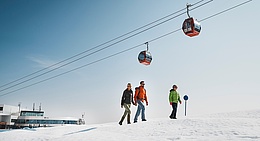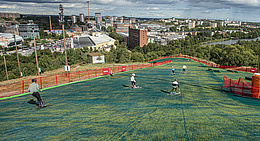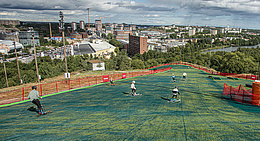“When the prince called for help, the brave princess rescued him from his plight and took him with her to her kingdom. From then on they reigned as queen and prince consort, and they had many more exciting adventures together.”
Tales of princesses are different now from what they were 20 years ago. In order to understand girls today and to appeal to them in a marketing context with the right products and experiences, we need to understand the changes that such narratives undergo in the course of time. Films, stories and also toys reflect current social realities – and thus also the role of women in society. This has changed considerably in recent decades.
Granted: For a very long time, stories about princesses served to maintain the status quo within our gender system. A tale was told in which marriage to a prince charming was the only source of fulfillment for the princess. Waiting for the prince was the only purpose in life, and looking after the home – while the prince was having his adventures in the great wide world – the only joy. But that stereotype has been obsolete for more than half a century now.
Girls today have other dreams
Girls’ dreams now encompass more than the song of the Graces from times gone by or the fairytale figures draped in pink tulle waiting to be rescued by the prince and carried off into the sunset on a white unicorn. The unicorns are still white, and the dresses still pink, but the narrative structure and content of the stories has changed.
Young girls today are confronted with different role models in film and television than 30 years ago. In the field of marketing we must therefore be careful to offer narratives for girls (and also for boys, of course) with protagonists that reflect their media reality.
When girls hear the word “princess” today, they mainly think of Elsa and Anna, the two sisters from the films Frozen I and II. Men, and princes in particular, play only supporting roles in the films. If the sisters need saving, they save themselves or each other, and the plot is a classic heroic narrative in which the heroine discovers her true self through her many adventures and thus gains new strength and courage for further heroic deeds.
Princes are no longer necessary – why should they be? The courage and conviction needed to triumph come from the heroine herself. Dependence on others is rejected. The self-confident heroine goes her own way. The prince (today: “love interest”) is more of a pretty accessory and maybe a nice reward at the end of the stony path.
Waiting for the prince: Snow White and Cinderella
This change in the image of women in film and television can be illustrated with reference to the princesses in Walt Disney films: The first princesses (Cinderella, Snow White) were strongly influenced by the female role models of the 1930s to 1950s and must be seen in the context of the values and female images of the time.
Snow White, actually a princess, does a great job as a housekeeper for the seven dwarves: She spends almost all of the time in the film cleaning until everything is spotless. When the prince appears on the scene, Snow White – after taking a bite from the poisonous apple – is looking pretty dead in a coffin. Only the prince can save her. It’s a similar story with Cinderella. Only when the Prince comes along is she rescued from her predicament and taken to the king’s palace. All she has to do is look pretty, do a good job with the housework (“The good ones into the pot …”) and sing nicely.
I’ve something to say, too: Ariel
Through the women’s liberation movements from the end of the 1960s to the 1990s, princesses became more independent and desired to shape their own lives. Ariel, the Little Mermaid (1989), marks the turning point from the passive princess to a self-empowered woman who takes her life into her own hands and is willing to make sacrifices for it – in this case her voice. In the end she gets her prince and decides for herself how she wants to live her life.
A fighter at the turn of the millennium: Pocahontas
A further development in the princess narrative is the story of Pocahontas as a woman who is willing to fight: She rejects the husband her father has chosen for her and follows her love for another. This is the first time in the history of Disney films that there is no happy ending with a prince but a happy end to a heroine’s journey. By drawing on her own strengths and overcoming her fears, the heroine finds the path to herself. But she has to take the hard decision to let her prince go.
It doesn’t always require a prince: Merida
The Scottish princess Merida (2012) wants to become an archer and is determined to go her own way in life. When her father presents her with three candidates for marriage – admittedly they are weaklings – she breaks free of her fate, disregards ancient and holy rules, flees from her father’s castle and, after many adventures and mystical encounters, becomes the archer she has always wanted to be and is set to follow her own path in life. In the end, marriage is out of the question, because who needs a prince when the princess herself is the best archer in the country ? It’s pure girl power, as was on the agenda in the Noughties.
Girl power: strong women on the path to becoming themselves
And that brings us back to Elsa and Anna, who embody the female image – the Girl Power – of the new age. These princesses are on the road to finding themselves. Elsa manages very nicely without a man; she is summoned by magical forces and is a determining element in the play of powers. She fights and she wins. She searches, she finds, and she rules over her doubts and fears with self-determination and through her own strength. Alone, she can freely develop her powers.
Heroines in the field of marketing
My tips for your young female target groups: Vary your narratives for girls: Little girls can still be captivated by the pink princess mythology, while older girls want more self-determination and depth. They want to learn how their heroines find their path to themselves and take control of their own lives – with or without a prince.
Another important point: girls are always keen to experience social interaction. So in your narratives, tell stories about how teams cooperate, friends help each other, and support comes from unexpected quarters. By the way, boys also find the modern go-for-it heroines much more interesting than the pink princesses of former times.

![[Translate to English:] Foto: shutterstock](/fileadmin/_processed_/c/8/csm_shutterstock_156350636_1af42c1fb1.jpg)
![[Translate to English:] Foto: shutterstock](/fileadmin/_processed_/6/d/csm_shutterstock_443087575_cae41f83ee.jpg)







![[Translate to English:] Photo: Adobe Stock](/fileadmin/user_upload/Aspen_Skyline_AdobeStock_192240489.jpeg)



